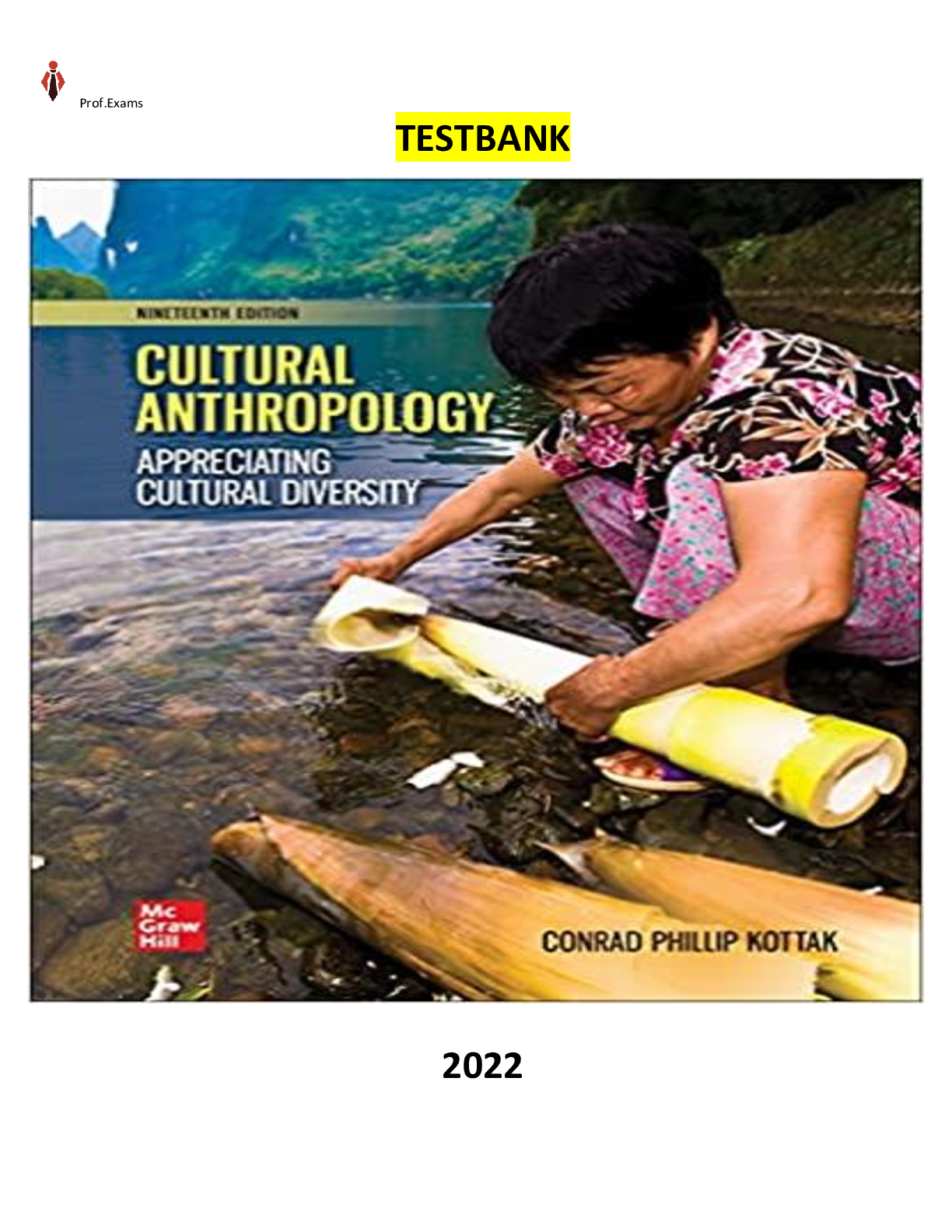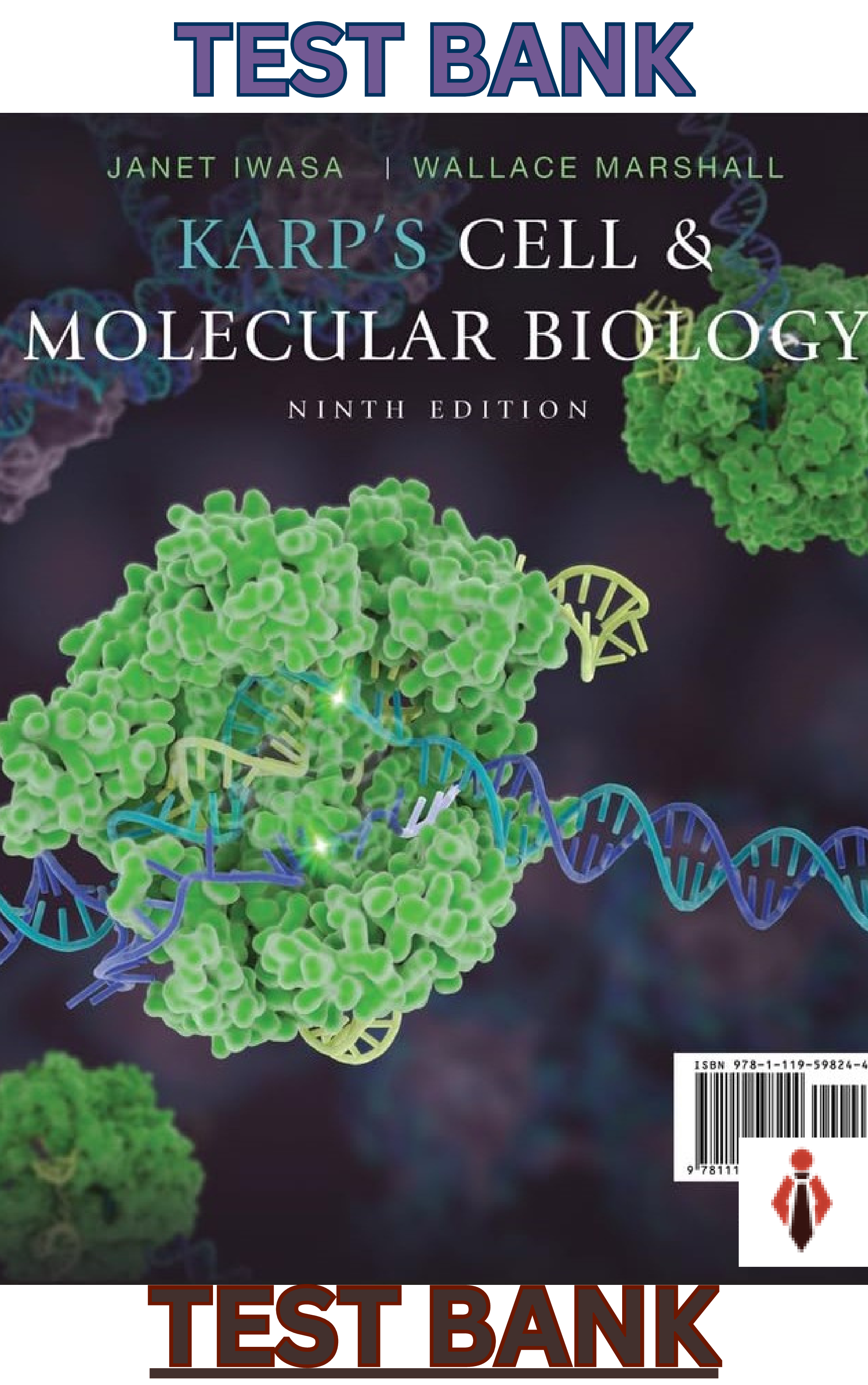Anthropology > TEST BANK > Elaborated Test Bank for Cultural Anthropology 19Ed.by Conrad Kottak- ALL Chapters included and Upda (All)
Elaborated Test Bank for Cultural Anthropology 19Ed.by Conrad Kottak- ALL Chapters included and Updated for 2023
Document Content and Description Below
Elaborated Test Bank for Cultural Anthropology 19Ed.by Conrad Kottak- ALL Chapters included and Updated for 2023Elaborated Test Bank for Cultural Anthropology 19Ed.by Conrad Kottak- ALL Chapters inclu... ded and Updated for 2023 COMPLETE - Elaborated Test Bank for Cultural Anthropology 19Ed.by Conrad Kottak- ALL Chapters included and Updated for 2022 TABLE OF CONTENTS Chapter 1 - What Is Anthropology? Chapter 2 - Culture Chapter 3 - Doing Anthropology Chapter 4 - Evolution, Genetics, and Human Variation Chapter 5 - The Primates Chapter 6 - Early Hominins Chapter 7 - The Genus Homo Chapter 8 - The First Farmers Chapter 9 - The First Cities and States Chapter 10 - Language and Communication Chapter 11 - Making a Living Chapter 12 - Political Systems Chapter 13 - Families, Kinship, and Marriage Chapter 14 – Gender Chapter 15 - Religion Chapter 16 - Ethnicity and Race Chapter 17 - Applying Anthropology Chapter 18 - The World System, Colonialism, and Inequality Chapter 19 – Anthropology’s Role in a Globalizing World 1) This chapter begins with a commonly heard opinion: "People are pretty much the same all over the world." Why is this assumption often wrong? How might your consideration of this understanding affect how you would design an anthropological study? 2) What is culture? How do anthropologists define and study culture? 3) What does holism refer to? Why is the concept central to anthropology? How does this concept relate to the "four-field" approach within the discipline? Have you encountered this concept in any of your other classes? 4) This chapter provides an example of human adaptation to high altitude to illustrate the various forms of cultural and biological adaptation. Can you think of another example that illustrates the broad capacity of humans to adapt both biologically and culturally? 5) To what does biocultural perspective refer? If you are planning to major in the biological sciences or planning a career as a medical doctor or clinical researcher, how might a minor in anthropology complement your education? If you are thinking of majoring in the humanities, how might a minor in anthropology complement your education? 6) This chapter considers differences and similarities between anthropology and other academic fields such as sociology. What about history? 7) Anthropology is the study of A) the psychological stages of human development. B) myths in industrial societies. C) the evolution of religion. D) long-term psychological adaptation. E) humans around the world and through time. 8) Anthropology as a holistic science refers to the study of the whole of the human condition: the past, the present, and the future of blank. A) math, physics, and astronomy B) faith and religion across the world C) biology, society, language, and culture D) geography and cartography E) ancient civilizations and archaeological remains 9) As humans organize their lives and adapt to different environments, our abilities to learn, think symbolically, use language, and employ tools and other products A) are shared with other animals capable of organized group life—such as baboons, wolves, and even ants. B) rest on certain features of human biology that make culture itself a biological phenomenon. C) rest on certain features of human biology that make culture, which is not itself biological, possible. D) prove that only fully developed adults have the capacity for culture; children lack the capacity for culture until they mature. E) have made some human groups more cultured than others. 10) Which of the following statements about culture is false? A) Culture is passed on genetically to future generations. B) Culture guides the beliefs and behavior of the people exposed to it. C) Cultural forces consistently mold and shape human biology and behavior. D) Culture is a key aspect of human adaptability and success. E) Culture is passed on from generation to generation. 11) What is the process by which children learn a particular cultural tradition? A) biological adaptation B) ethnology C) enculturation D) ethnography E) acculturation 12) This chapter's description of how humans cope with low oxygen pressure in high altitudes illustrates A) how in matters of life or death, biology is ultimately more important than culture. B) how human plasticity has decreased ever since we embraced a sedentary lifestyle some 10,000 years ago. C) how biological adaptations are effective only when they are genetic. D) human capacities for cultural and biological adaptation, the latter involving both genetic and physiological adaptations. E) the need for anthropologists to pay more attention to human adaptation in extreme environments. 13) The presence of more efficient respiratory systems to extract oxygen from the air among human populations living at high elevations is an example of which form of adaptation? A) short-term physiological adaptation B) long-term physiological adaptation C) cultural adaptation D) symbolic adaptation E) genetic adaptation 14) Over time, humans have become increasingly dependent on which of the following in order to cope with the range of environments they have occupied in time and space? A) biological means of adaptation, mostly thanks to advanced medical research B) social and cultural means of adaptation C) a holistic and comparative approach to problem-solving D) technological means of adaptation, such as the creation of virtual worlds that allow us to escape from day-to-day reality E) social institutions, such as the state, that coordinate collective action 15) Today's global economy and communications link all contemporary people, directly or indirectly, in the modern world system. People must now cope with forces generated by progressively larger systems—the region, the nation, and the world. For anthropologists studying contemporary forms of adaptation, why might this be a challenge? A) Anthropological research tools do not work in this new modern world system, making their contributions less valuable. B) A more dynamic world system, with greater and faster movements of people across space, speeds up the process of evolution, making the study of genetic adaptations more difficult. C) Since cultures are tied to place, people moving around and connecting across space means the end of culture, and thus the end of anthropology. D) Truly isolated indigenous communities, anthropology's traditional and ongoing study focus, are becoming harder to find. E) According to Marcus and Fischer (1986), "The cultures of world peoples need to be constantly rediscovered as these people reinvent them in changing historical circumstances." 16) The academic discipline of anthropology includes four main subfields. They are sociocultural anthropology, anthropological archaeology, biological anthropology, and . A) linguistic anthropology B) psychosociological archaeology C) scientific–humanistic studies D) genetical anthropology E) biological archaeology 17) What are the four subdisciplines of anthropology? A) genetic anthropology, physical anthropology, psychological anthropology, and anthropology and linguistics B) primatology, ethnology, cultural anthropology, and paleoscatology C) biological anthropology, linguistic anthropology, cultural anthropology, and archaeology D) archaeology, biological anthropology, applied linguistics, and applied anthropology E) medical anthropology, ethnography, ethnology, and cultural anthropology 18) Anthropologists' early interest in Native North Americans A) is an important historical reason for the development of four-field anthropology in the U.S. B) was more important than interest in the relation between biology and culture in the development of U.S. four-field anthropology. C) proved early on that culture is a function of race. D) was replaced in the 1930s by the two-field approach. E) is unique to European anthropology. 19) How are the four subfields of U.S. anthropology unified. [Show More]
Last updated: 1 year ago
Preview 1 out of 409 pages
Instant download

Instant download
Reviews( 0 )
Document information
Connected school, study & course
About the document
Uploaded On
Mar 28, 2023
Number of pages
409
Written in
Additional information
This document has been written for:
Uploaded
Mar 28, 2023
Downloads
0
Views
110






























